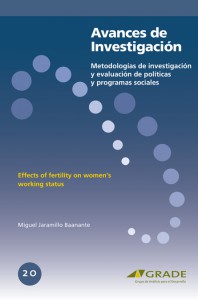Effects of fertility on women’s working status
| Year | : | 2016 |
|---|---|---|
| Author/s | : | Miguel Jaramillo |
| Area/s | : | Methodologies for research and evaluation of policy and programmes |
Jaramillo, Miguel (2016). Effects of fertility on women’s working status. Avances de Investigación, 20. Lima: GRADE.
As in other developing countries, Peru’s demographic transition is well underway. Concurrently, women’s labor market participation and employment rates have substantially increased. In this paper the authors estimate the causal effect that the reduction in fertility rates has on women’s employment using instrumental variables already tested in developed countries—twins in the first birth and the sex composition of the two oldest children. The authors also analyze the heterogeneity of the effects along three lines: marriage status of the mother, age of the first (second) child, and mother’s level of education. The authors find strong effects of fertility. According to our results, 27 percent of the total increase in women’s rate of employment between 1993 and 2007 can be attributed to the reduction in fertility rates. This is a considerable magnitude, more than four times as large as the estimate for US by Jacobsen et al. (1999). Effects are largest in women with children 2 years old or younger and decline inversely as the first child increases in age, but are still significant when he or she reaches 10. Effects also vary with the mother’s education level, tending to be stronger when women have more education. Finally, these effects are smaller for married women than for all women.






